Unit 4 Table of Contents
Masks with Meaning May Dance
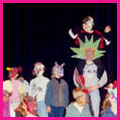
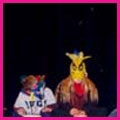
Click on a thumbnail to view the entire picture.
- Major Issues
- Materials and Technique Explorations
- Introductions
- Objectives
- Materials and Resources
- Add New Knowledge
- Creation
- Assessments
- Extensions
- References
- Discussions
1. Major Ideas Connected to Theory Text Chapters
- Understanding how masking iconography uses symbols, shape, proportion and color to deliver a message (affective expression).
- Understanding of mask making as metaphor.
- Exploring cultural identity symbols.
- Experiencing performance development as an integrated arts assessment strategy.
2. Materials and Technique Explorations
- Clay hand/slab building skills and procedures
- Plaster casting skills and procedures
3. Introduction
Definition Of a Mask
When students incorporate their visual culture and ethnic culture iconography in their art making, this unit becomes especially powerful as a pathway to self actualization and reflection. Cultural reflection is the foundation for helping a student formulate an awareness of self identity.
There is something seductive about the opportunity to change our identity. I have found students eager to create and use masks to role play, create and act out imaginings, students love to play with changing their identity. I believe masking encourages risk taking because you "become" someone or something else when you don the mask. Every art textbook has a mask lesson. What makes this one different?
My doctoral dissertation was a multi-methodological study that observed a control group (no cultural research) directed to "make a mask that tells something about yourself" and an experimental group following a unit similar to what you see here in this unit. The control group chose to express themselves in the simplest terms. I fondly came to call the control group "the ball heads" - which predominated. The experimental group produced varied and textual masking interpretations. Encouraging students to incorporate the iconography from their life world will expand their options and development of self-identity.
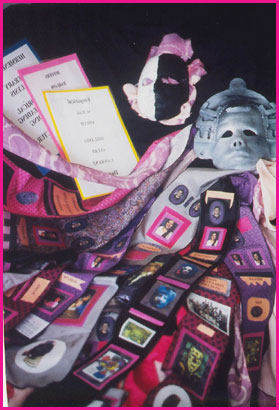
Doctoral Mask "Multiple Perspectives"
This unit will provide the opportunity for students to investigate their ethnic or popular culture roots. An understanding of personal identity is a powerful and essential need for early adolescence. The students will also understand the power of integrating performance as an information delivery strategy.
Student Created Culture Masks: [1], [2]
4. Objectives
Students create performances with the masks.
Given access to information and history focused on images and symbols from their culture (it could be ethnic or popular, or cultural specifics from their imaginations), the students may create a metaphor mask from clay or plaster and develop a performance to deliver their metaphor to their community.
Specific Activities Leading to Objectives
Students may:
- Investigate how and why cultures create visual metaphor and symbols by constructing a magical mask metaphor representing their chosen "culture". The culture may be ethnic, social, or created and named by the student.
- Demonstrate the understanding of the relationship between masks, metaphor and culture by their chosen "culture" from a critically reflective and multiple perspectives point of view.
- Demonstrate an understanding of magic and its association with mask-making traditions in their own and others' cultures.
- Create a mask successfully employing the design concepts of shape, proportion, and color.
- Develop a performance to communicate the metaphor to their community.
- Demonstrate the technical skills necessary to create a mask metaphor from clay
5. Materials/Resources Needed
- Idea Book
- Five masks for deconstruction and interpretation (supplied digitally from the Author's collection but you might also try to have a few masks for the students to handle).
- Teacher may want to spend time researching masking traditions, especially masking traditions from the predominate cultural origins of your students. You may include at
least one "everyday" mask - like a hockey, winter, welding, or Halloween mask.
- KEYWORD SEARCH: Masking Traditions from Mexico or Germany or Masking iconography etc.
- Interactive Color Wheel
- Elements and Principles Interactive Site (we could have free permissions from the Walker Art Center's site)
- Video Clips
- Clay slab studio
- Plaster cloth
- Newspaper
- Saran Wrap
- Vaseline
- Clay
- Clay tools
- Kiln
6. Add New Knowledge
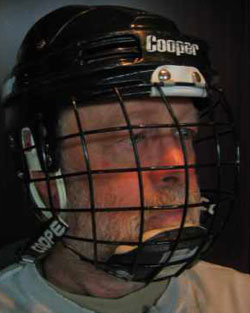
Critical Thinking Questions:
- Where is this mask used? Has anyone worn a mask like this? What did it feel like? Did you feel safe? Claustrophobic? Was it hard to see?
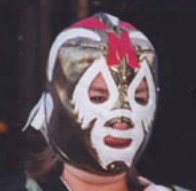
Critical Thinking Questions:
- Have you seen a mask like this? Do you think this mask was worn in the United States?
- Hint: This Mask is from Mexico.
- Hint # 2. The M on the forehead stands for mil.
- Hint # 3 Mil means "thousand" in Spanish
I purchased this mask from a wrestler in Mexico who named himself:
Mil Mascara
The Man of a Thousand Masks!
- If you could choose a new name, what would it be?
Click Here For More Everyday Masks
Snappy Launch (AKA Anticipatory Set) The teacher may bring and/or ask the students to bring a mask they have at home (or create one on paper if they do not have one to bring). It can be ANY mask - cultural, hockey, Halloween, tourist, etc. Criteria: The mask conceals the wearer's identity. The teacher may make a list of the masks the students have in their everyday lives.
Critical Thinking Questions focused on the Snappy Launch masks brought in by the students, teacher and/or everyday masks above:
- What is the purpose of this mask? Is this mask special to you? Why?
- Who made it?
- Is it worth a lot of money? Is this question important? Why or why not?
- What are the colors on the mask.
- What shape is it?
- What are the symbols you see on the mask? What do they mean?
- What kind of clothing do you think was worn with the mask?
- Make up a story about the mask.
- Could this mask be used any place in the world?
- How does looking and thinking about this mask make you feel?
Optional Extension:
Students might switch their masks with a partner and improvise a 15-second "performance" inspired by the mask. It could be a dance, speech, poem, dramatic nugget - or all four.
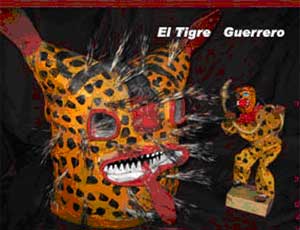
This mask is used in the Holy Cross ceremony on May 3rd, 4th and 5th.
Men from different barrios (neighborhoods) wear jaguar costumes and masks and challenge each other in fighting competitions that include beating each other with knotted ropes.
The impressive masks are made from very hard leather and worn over the head to protect the dancer. The masks are painted green or yellow, depending which town or barrio the dancer is from.
The celebration of Holy Cross is a ceremony during which different traditions are offered to invite the rain god (Tlaloc) to be kind.
Critical Thinking Questions focused on the author's masks:
- Do any of these masks have magical properties? Describe them.
- What do these masks have in common?
- Identify the symbols used on the masks.
- Describe a mask used in everyday life.
- Describe a magical mask you have seen.
- Do masks always hide the identity of the wearer?
- Describe the masks you have brought from home. Be symbol detectives.
The teacher may now ask the students to choose or invent a culture.
A. If the students have chosen an existing culture, they need to complete research on the symbols and masks of that culture. KEYWORD SEARCH : Symbols of Mexico, iconography of Ireland etc.
B. If the students have chosen to invent a culture they need to identify the symbols, music, image, history etc. of the culture they create.
Click here for a student created culture.
Critical Thinking Questions focused on masks and changing your identity:
- Why did people want to hide their identity in the past? (Often to poke fun at the people in charge. The ruling elite, as they are often called, are the people who hold the power and are the decision makers of the community.
- Why did Superman, Batman and Spiderman want to hide their identities?
- Why might YOU like to hide your identity?
- Name all the GOOD wearers of masks.
- IMPORTANT CRITERIA: You should try to create a mask that will help make the world a better place.
Vocabulary Building
Grades 4-6
- Ceramics -- usually clay, fired at a high temperature to create a hard, brittle object.
- Kiln -- an oven used to bake or fire ceramics /clay.
- Fire -- the term used to describe baking the ceramics/clay
- Slab -- ceramics can be made on a pottery wheel or by rolling out thin slabs
- Wedge -- throwing and kneading the clay to remove all bubbles or air pockets
- Score --using a hard metal or wood object, making crosshatch marks on two pieces of clay you plan to join together.
- Coil --a technique used in slab ceramics. A coil is a long stand of clay rolled like a snake.
- Culture -- the religion, morals, manners, traditions, beliefs of a group of people
- Identity -- the distinct personality of an individual
- Metaphor -- an idea or image conceived to represent something else: a symbol
- Symbol -- image, word, music, dance etc that represents something else
- Magic -- the practice of charms, spells, and rituals to control events or produce Supernatural effects.
- Avatar -- a character created from imagination. This character may have magical powers like Spiderman or Hercules.
Quiz Yourself
(OPITIONAL) Students may study the vocabulary words for ten minutes. They could practice with a partner. The teacher might have the students use the Jeopardy Style Vocabulary Drill (Under Construction) for added retention.
Reflect for Greater Depth
* The students may complete the personal ethnic/cultural historical research in their Idea Book. The students may create a new culture with new symbol ideas for their magical metaphor mask in their Idea Book.
View an example of an idea book.
7. Creation
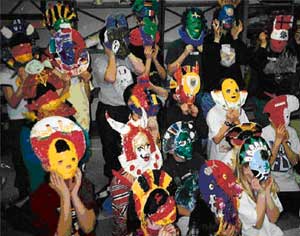
Plaster Masks on Their Creators
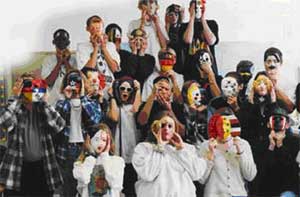
Clay Masks on Their Creators
Planning
- The students may create draft one of their magical metaphor mask in their Idea Book. The students may share their ideas in small groups for peer feedback. The students might take notes in their Idea Books.
- The students should be encouraged to create masks which will help make the world a better place. This unit is not intended to encourage students to play out negative fantasies.
- The students may create their final draft for their mask in their Idea Books. The students may label all the parts and include found objects and colors.
Visual Creation
The students will create their masks.
Click here for plaster procedure.
NOTE: Many schools have chosen to make the plaster procedure their final mask end-product. Click here for student plaster examples.
Click here for clay procedure.
Written Creation
Individual artist's statement
The students may write the artist's statement describing the symbols and attributes of their
finished mask. Students might include a title (the title might be a clue to the metaphor message of their mask), a summary of the historical research they executed to select the symbols, and the purpose of the mask.
Presentation - (Optional) Integrated Arts Assessment
The teacher may offer to hold a community, all-class or all-school viewing of the various
performances and/or masks created. The teacher may encourage the students to create a presentation for the community AND INVITE THE AUDIENCE TO GUESS THE METAPHOR. The purpose of the presentation is to deliver the mask metaphor to the audience. Send invitations to parents, the press, business leaders, administrators, and other schools in the district. This unit has wonderful opportunities for community building and art program promotion!
8. Assessment
Download the assment form for students or teachers.
9. Extensions and Teacher Submissions
Interdisciplinary extension ideas with dance, literature, social studies, etc: [1], [2], [3], [4]
10. References
Tavin, K., (2003) Wrestling with angels, searching for ghosts: Toward a critical pedagogy
of visual culture, Studies in Art Education 44 (3) 197-213
Campbell, J. (1989). Historical atlas of world mythology: The way of the seeded earth.
Netherlands: Joseph Campbell Trust.
Editrice, A., (1988) Le maschere venezizne. Vicenza: Museo Bottacin
Holm, B., (1999). Northwest coast indian art. Seattle:University of Washington Press
Lechuga, R., (1994). Mask arts of mexico. Vancouver, B.C.: Raincoast Books
Leon-Portilla, M. (1969). Aztec thought and culture: A study of the ancient nahuatl mind.
Norman: University of Oklahoma Press.
Lund, D., (1983) Minnesota’s chief flat mouth of leech lake. Staples, MN: Nordell Graphics Communications.
Philip, N., (1995). The illustrated book of myths. New York: Houghton Mifflin.
Prescott, W. H. (1962). The Conquest of mexico. Great Britain: J. M. Dent & Sons.
Tallant, R., (1994). Mardi gras- as it was. Gretna, La: Pelican Publishing Co.
Whetten, N. I. (1948). Rural mexico. Chicago: The University of Chicago Press
11. Discussion
The software you select should have the possibility of threaded software at the minimum. Curriculum module capability, like Desire to Learn or WebCT would be a bonus. I would enjoy an opportunity to take you for a visit in the online class I am teaching this summer for ideas.
Possible topics:
- Ask Dr. B
- Messages from Dr. B
- Tip of the Week
- Hot Resources
- Teaching Online Forum
- Events
- Workshops (We may be able to partner for college credit, if you are interested).
- Teacher's Lounge
- Special Speakers
- Order "Children's Art Education: A Practical Approach to Visual Culture".
|